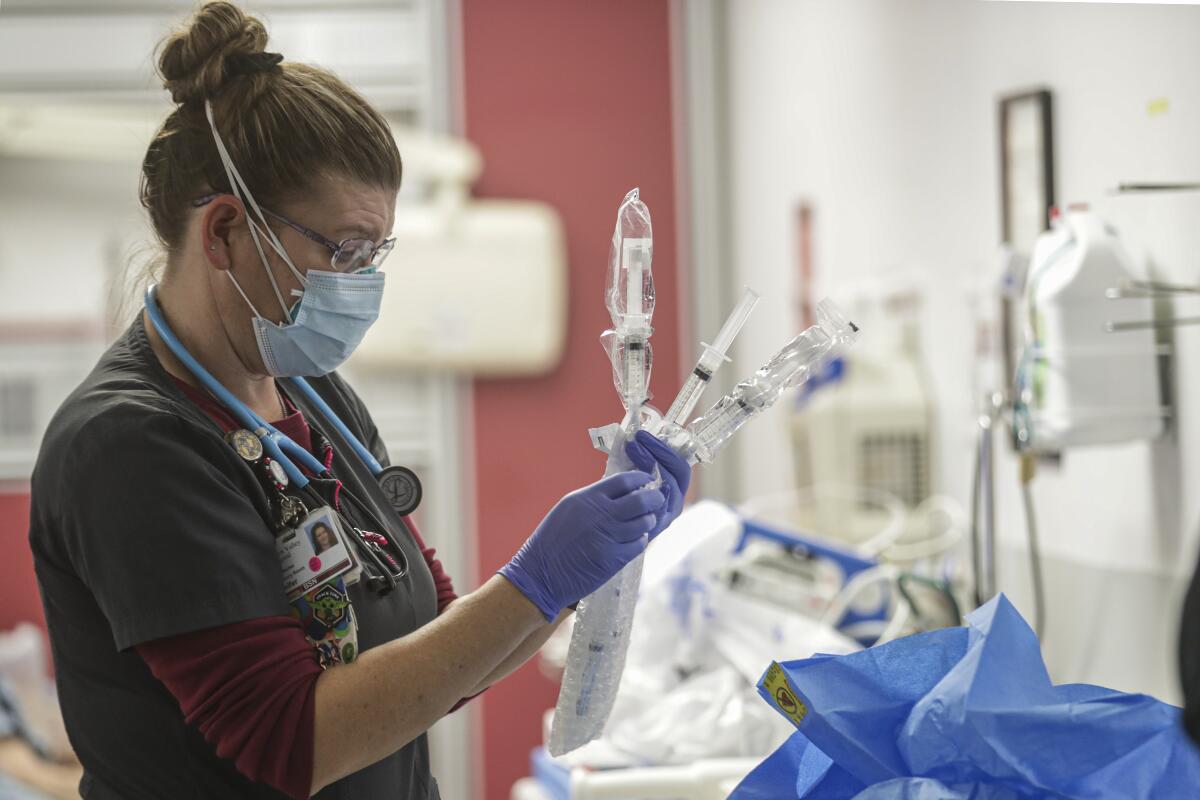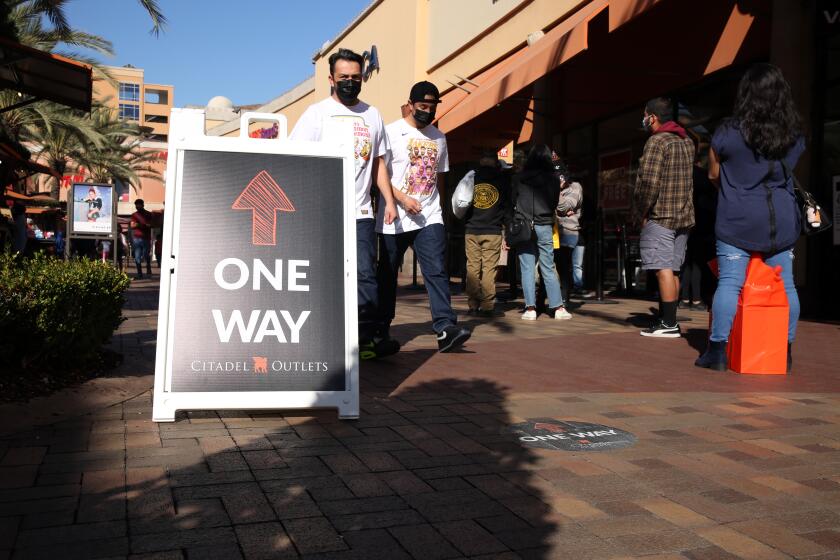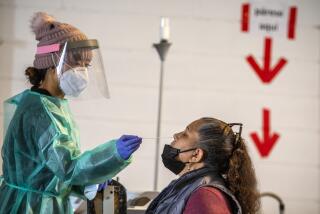California becomes the first state to surpass 2 million coronavirus cases

- Share via
California has now recorded more than 2 million coronavirus cases since the start of the pandemic, according to a county-by-county tally conducted by The Times, the first state in the nation to reach that alarming milestone and another marker of the wrenching toll the virus is inflicting.
The novel coronavirus has been spreading with unprecedented speed in recent weeks, creating crisis conditions in hospitals and making California one of the hardest-hit parts of the United States. Available capacity at intensive care units across Southern California and the San Joaquin Valley remains at 0%.
Hospitals throughout Los Angeles County are now strained and overwhelmed, Health Services Director Dr. Christina Ghaly said Wednesday. At certain points of the day Tuesday, 96% of all hospitals in L.A. County were diverting certain kinds of ambulances to hospitals farther away because they were so full, a figure that is usually only 33% at this time of year.
Ambulances had to wait hours to offload into crowded emergency rooms, and scheduled surgeries are being postponed to make way for COVID-19 patients.
Should socializing among people from different households go on at Christmas and New Year, officials and experts across the state warned of a disaster not seen in the modern era in California’s hospitals.
“It is a situation that could easily become catastrophic in January, if we have this surge upon a surge,” Ghaly said. “It is very important that people follow the guidance that is being issued virtually everywhere you look and listen — which is to stay home for the holidays and don’t take the opportunity, as much as you might want to, to interact with those outside of your household.”
The risk of dying from COVID-19 in a hospital could go up dramatically as ICU nurses and doctors are stretched beyond capacity.
Currently, about half of all ICU beds in L.A. County are filled with COVID-19 patients. Two out of three of them are suffocating due to the coronavirus-triggered inflammation that is destroying their lungs, Ghaly said.
“They’re suffocating to the point that they can no longer breathe on their own, and they have to have someone put a tube down their throat in order to oxygenate their organs,” Ghaly said. “Many of these people will not live to see 2021.”
Ghaly forecast that on top of L.A. County’s cumulative death toll of 9,165, nearly 7,000 more people may die of COVID-19 by the end of January if trends continue.
“These people did not need to die,” she said. “We have never seen daily death rates this high throughout the course of the pandemic, and the model predicts that the worst is yet to come.” An average of 85 people a day are now dying of COVID-19 over the past week; that figure was 10 on Election Day, Nov. 3.
Los Angeles County reported one of its deadliest days yet in the COVID-19 pandemic Wednesday. The additional 134 deaths, as tallied by The Times, equals the previous single-day highest tally of deaths of 134 seen on Dec. 16.
Officials voiced deep worry that people planned to gather for Christmas just as they did during Thanksgiving, a simultaneous rejection of pleas by public health officials that has led to the deadliest phase of a pandemic in a century.
“I am very worried today that there are thousands of L.A. County residents whose actions are creating tremendous risks and contributing to the continued surge in cases, hospitalizations and deaths,” said L.A. County Public Health Director Barbara Ferrer.
“Please stay put and don’t travel anywhere,” Ferrer said, noting the recent death of an airline passenger on a flight from COVID-19.
L.A. County is a big driver of the state’s soaring coronavirus case tallies recently, as more than 316,000 cases have been added across California in the seven-day period that ended Tuesday. In that time period, L.A. County tallied roughly 103,000 cases; the Inland Empire, 70,000 cases; Orange County, 22,000 cases; San Diego County, 21,000 cases; Fresno County, 14,000 cases; and Santa Clara County, 8,000.
More than half a million new coronavirus cases statewide have been added in just the last two weeks. California now ranks third among the 50 states, the District of Columbia and Puerto Rico in number of new coronavirus cases per 100,000 residents over the last two weeks.
It took almost 10 months for California to record its millionth confirmed coronavirus case. The state tallied its second million in just six weeks.
Cumulatively, California ranks 36th among the 50 states, the District of Columbia and Puerto Rico in number of coronavirus cases per 100,000 residents.
The strain of the worst wave of the pandemic was clear across the state, from L.A. to the Central Valley to Silicon Valley.
In Santa Clara County, there were 68 people waiting in emergency rooms throughout Silicon Valley on Tuesday because there were no beds available. If people gather again for the holidays, officials forecast a crisis that would’ve been unthinkable just a few months ago.
“We are talking about people in gurneys without a bed to go to. We are talking about people not getting hospital care. We got talking about rationing what scarce resources our exhausted health system has left to those who will benefit the most,” said Dr. Ahmad Kamal, director of health preparedness for Santa Clara County.
Malls have continued to welcome holiday shoppers, even as officials have banned other forms of gathering amid a massive surge in coronavirus cases.
Fresno County is now averaging 1,761 cases a day over the past week, 14 times the daily average from Nov. 1, when the county was averaging 123 cases a day. Fresno County reported 89 deaths Tuesday; previously, the single-day high was 28, which happened Dec. 11.
Fresno County is now averaging 13 deaths a day from COVID-19 over the last seven days; the comparable number from Thanksgiving was two.
“It really feels like we’re running out of time for really helping out as many people as we can,” said the Fresno County interim health officer, Dr. Rais Vohra. Noting the optimism with the arrival of the vaccine, “we’re seeing the light at the end of the tunnel. That’s absolutely true. But it also feels like the tunnel is narrowing, which is very terrifying. And it’s just a race against time to try to get people through this tunnel as safely as possible.”
More than 23,000 Californians have died from COVID-19 since the pandemic began, a milestone crossed Tuesday. Over the last two weeks, more than 3,000 have died — a staggering number that accounts for 13% of the state’s more than 23,600 total fatalities.
An average of 250 Californians who have been infected with the coronavirus are dying every day over the past week.
Those numbers serve as a “sober, sober reminder of how deadly this disease is, and how tragic the loss of every life is,” Gov. Gavin Newsom said Wednesday.
“This disease remains deadly,” he said Wednesday. “This pandemic remains deadly.”
On Tuesday, 375 deaths were reported statewide, according to The Times’ tally, marking the second worst death toll in a single day, just short of the record recorded Dec. 16, when 394 deaths were recorded. On Wednesday, 345 more deaths were recorded.
The rapidly increasing number of deaths is the grimmest, but not the only, repercussion of COVID-19’s rampage across L.A. County and the state.
Infections have soared in recent weeks, pushing unprecedented numbers of patients into California’s hospitals.
On Tuesday, the most recent day for which complete data are available, there were record-high numbers statewide of COVID-19 hospitalizations — 18,448 — and patients in intensive care — 3,827.
In L.A. County, home to 10 million people, a point-in-time survey found that there were 30 available ICU beds as of 9 a.m. Sunday. A similar tally last week found 69.
“Today, we’re over 100% of our usual patient volume, and of that volume, 52% of our inpatients are patients diagnosed with COVID,” Greg Adams, chairman and chief executive of Kaiser Permanente, said Tuesday. “Sixteen of our 36 hospitals are already above 100% occupancy in our ICUs. We’re struggling to add capacity for COVID patients as we speak.”
Already, hospitals are having to step up measures to ensure that the sickest patients get the highest level of care possible. That includes moving some patients who would typically be in the ICU to other areas of the hospital, such as a recovery area, or keeping them in the emergency room for longer than normal.
More to Read
Sign up for Essential California
The most important California stories and recommendations in your inbox every morning.
You may occasionally receive promotional content from the Los Angeles Times.














